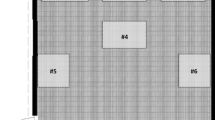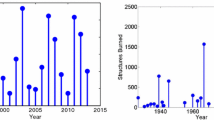Abstract
With the significant growth of the world population, our cities are becoming more and more crowding. In this situation, any fire occurring would cause severe consequences, including property damage and human injuries or even deaths. In assessing the fire cause, the fire origin determination is a crucial step identifying the origin of fire outbreak and the sequential fire and smoke propagation. Traditionally, fire investigators relied upon the visible fire damages at the fire scene to determine the location of fire originated based on their own professional experience. The fire origin determination process is, however, subject to the expert interpretation inherently embedded in the qualitative analyses. Aiming to develop an alternative methodology assisting the fire investigation, we proposed a new Multi-fidelity Kriging algorithm to quantitatively determine the fire origin based on the soot deposition patterns predicted by the numerical simulations. The advantage of the Multi-fidelity Kriging is its capacity in maintaining a reliable accurate prediction with a very limited computational requirement in simulations. The algorithm is tested against a total of 41 different fire origins in a single compartment (i.e. 5 m width × 5 m length × 4 m height) with only 1 doorway for ventilation. The test results demonstrated that the Multi-fidelity Kriging algorithm is capable to predict the fire origin based on the simulated soot deposition pattern while posing significant saving to the computational cost by correcting low-fidelity samples based on knowledge extract on high-fidelity simulation results.














Similar content being viewed by others
References
Association NFP (2013) NFPA 921: Guide for fire and explosion investigations. Technical Committee on Fire Investigations
Bryner N, Madrzykowski D, Grosshandler W (2007) Reconstructing the station nightclub fire–computer modeling of the fire growth and spread. In: International interflam conference, 11th proceedings, pp 3–5
Galea ER, Wang Z, Veeraswamy A, Jia F, Lawrence PJ, Ewer J (2008) Coupled fire/evacuation analysis of the Station Nightclub fire. Fire Saf Sci 9:465–476
Shen T-S, Huang Y-H, Chien S-W (2008) Using fire dynamic simulation (FDS) to reconstruct an arson fire scene. Build Environ 43(6):1036–1045
Chi JH (2013) Reconstruction of an inn fire scene using the fire dynamics simulator (FDS) program. J Forens Sci 58(s1):S227–S234
Yuen A, Yeoh G, Alexander R, Cook M (2014) Fire scene reconstruction of a furnished compartment room in a house fire. Case Stud Fire Saf 1:29–35
Jahn W, Gonzalez O, de Dios Rivera J, Torero JL (2015) Using computational fluid dynamics in the forensic analysis of a prison fire. Forens Sci Int 253:e33–e42
Varol Y, Avci E, Koca A, Oztop HF (2007) Prediction of flow fields and temperature distributions due to natural convection in a triangular enclosure using adaptive-network-based fuzzy inference system (ANFIS) and artificial neural network (ANN). Int Commun Heat Mass Transf 34(7):887–896
Zhou L, Haghighat F (2009) Optimization of ventilation system design and operation in office environment. Part I: methodology. Build Environ 44(4):651–656
Zhou L, Haghighat F (2009) Optimization of ventilation systems in office environment. Part II: results and discussions. Build Environ 44(4):657–665
Stavrakakis GM, Karadimou DP, Zervas PL, Sarimveis H, Markatos NC (2011) Selection of window sizes for optimizing occupational comfort and hygiene based on computational fluid dynamics and neural networks. Build Environ 46(2):298–314
Li K, Su H, Chu J, Xu C (2012) A fast-POD model for simulation and control of indoor thermal environment of buildings. Build Environ 60:150–157. https://doi.org/10.1016/j.buildenv.2012.11.020
Li K, Xue W, Xu C, Su H (2013) Optimization of ventilation system operation in office environment using POD model reduction and genetic algorithm. Energy Build 67:34–43
Okayama Y (1991) A primitive study of a fire detection method controlled by artificial neural net. Fire Saf J 17(6):535–553
Milke JA, McAvoy TJ (1995) Analysis of signature patterns for discriminating fire detection with multiple sensors. Fire Technol 31(2):120–136
Lee W, Yuen K, Lo S, Lam K (2000) Prediction of sprinkler actuation time using the artificial neural networks. J Build Surv 2(1):10–13
Li Z, Khananian A, Fraser RH, Cihlar J (2001) Automatic detection of fire smoke using artificial neural networks and threshold approaches applied to AVHRR imagery. IEEE Trans Geosci Remote Sens 39(9):1859–1870
Lee EW, Yuen RK, Lo S, Lam K, Yeoh G (2004) A novel artificial neural network fire model for prediction of thermal interface location in single compartment fire. Fire Saf J 39(1):67–87
Yuen RK, Lee EW, Lo S, Yeoh G (2006) Prediction of temperature and velocity profiles in a single compartment fire by an improved neural network analysis. Fire Saf J 41(6):478–485
Lo S, Liu M, Zhang P, Yuen RK (2009) An artificial neural-network based predictive model for pre-evacuation human response in domestic building fire. Fire Technol 45(4):431–449
Maeda EE, Formaggio AR, Shimabukuro YE, Arcoverde GFB, Hansen MC (2009) Predicting forest fire in the Brazilian Amazon using MODIS imagery and artificial neural networks. Int J Appl Earth Obs Geoinf 11(4):265–272
Erdem H (2010) Prediction of the moment capacity of reinforced concrete slabs in fire using artificial neural networks. Adv Eng Softw 41(2):270–276
Safi Y, Bouroumi A (2013) Prediction of forest fires using artificial neural networks. Appl Math Sci 7(6):271–286
Atiya A, Ji CJItonn (1997) How initial conditions affect generalization performance in large networks. IEEE Trans Neural Netw 8(2):448–451
Taroni F, Aitken CG, Garbolino P, Biedermann A (2006) Bayesian networks and probabilistic inference in forensic science. Wiley, Amsterdam
Tinsley A, Gorbett G (2013) Fire investigation origin determination survey. Fire Arson Investig J Int Assoc Arson Investig 63:24–40
Beyler CL (2009) Analysis of the fire investigation methods and procedures used in the criminal arson cases against Ernest Ray Willis and Cameron Todd Willingham. Hughes Associates, Toronto
Yeoh G, Yuen R, Chen D, Kwok W (2002) Combustion and heat transfer in compartment fires. Numer Heat Transf Part A Appl 42(1–2):153–172
Yeoh G, Yuen R, Lee E, Chueng S (2002) Fire and smoke distribution in a two-room compartment structure. Int J Numer Methods Heat Fluid Flow 12(2):178–194
Ko BC, Cheong K-H, Nam J-Y (2009) Fire detection based on vision sensor and support vector machines. Fire Saf J 44(3):322–329
Zhao B (2009) Modeling pressure drop coefficient for cyclone separators: a support vector machine approach. Chem Eng Sci 64(19):4131–4136
Zhao J, Zhang Z, Han S, Qu C, Yuan Z-Y, Zhang D (2011) SVM based forest fire detection using static and dynamic features. Comput Sci Inf Syst 8(3):821–841
Yang X, Wang J, He S (2012) A SVM approach for vessel fire detection based on image processing. Paper presented at the proceedings of international conference on modelling, identification and control (ICMIC)
Cressie N (1990) The origins of kriging. Math Geol 22(3):239–252
Stein ML (2012) Interpolation of spatial data: some theory for kriging. Springer, New York
Handcock MS, Stein ML (1993) A Bayesian analysis of kriging. Technometrics 35(4):403–410
Van Beers W, Kleijnen JP (2004) Kriging interpolation in simulation: a survey. Paper presented at the Proceedings of the 2004 Winter Simulation Conference
Sivia D, Skilling J (2006) Data analysis: a Bayesian tutorial. OUP, Oxford
Wikle CK, Berliner LM (2007) A Bayesian tutorial for data assimilation. Physica D 230(1):1–16
Forrester A, Sobester A, Keane A (2008) Engineering design via surrogate modelling: a practical guide. Wiley, Amsterdam
Krige DG (1951) A statistical approach to some basic mine valuation problems on the Witwatersrand. J South Afr Inst Min Metall 52(6):119–139
Gano SE, Renaud JE, Martin JD, Simpson TW (2006) Update strategies for kriging models used in variable fidelity optimization. Struct Multidiscip Optim 32(4):287–298
de Baar J, Roberts S, Dwight R, Mallol B (2015) Uncertainty quantification for a sailing yacht hull, using multi-fidelity kriging. Comput Fluids 123:185–201
Forrester AI, Sóbester A, Keane AJ (2007) Multi-fidelity optimization via surrogate modelling. Paper presented at the Proceedings of the royal society of london a: mathematical, physical and engineering sciences
Riahi S, Beyler CL, Hartman J (2013) Wall smoke deposition from a hot smoke layer. Fire Technol 49(2):395–409
Talbot L, Cheng R, Schefer R, Willis D (1980) Thermophoresis of particles in a heated boundary layer. J Fluid Mech 101(04):737–758
Ciro WD, Eddings EG, Sarofim AF (2006) Experimental and numerical investigation of transient soot buildup on a cylindrical container immersed in a jet fuel pool fire. Combust Sci Technol 178(12):2199–2218
Cohan BD (2010) Verification and validation of a candidate soot deposition model In fire dynamics simulator version 5.5. 1
Hartman J, Beyler A, Riahi S, Beyler C (2012) Smoke oxidation kinetics for application to prediction of clean burn patterns. Fire Mater 36(3):177–184
Gottuk D, Mealy C, Floyd J (2008) Smoke transport and FDS validation. Fire Saf Sci 9:129–140
Cheung SC, Yeoh G (2009) A fully-coupled simulation of vortical structures in a large-scale buoyant pool fire. Int J Therm Sci 48(12):2187–2202
McGrattan KB, Baum HR, Rehm RG (1998) Large eddy simulations of smoke movement. Fire Saf J 30(2):161–178
He Y, Fernando A, Luo M (1998) Determination of interface height from measured parameter profile in enclosure fire experiment. Fire Saf J 31(1):19–38
Gorbett GE, Meacham BJ, Wood CB, Dembsey NA (2017) Structure and evaluation of the process for origin determination in compartment fires. Fire Technol 53(1):301–327
Lewis JP (1995) Fast normalized cross-correlation. Paper presented at the Vision interface
Acknowledgements
The financial support provided by an Australian Research Council Grant (ARC Linkage LP130100236) is gratefully acknowledged. The work described in this paper was partly supported by a Grant from the Research Grants Council of the Hong Kong Administrative Region, China [Project No. CityU 116613].
Author information
Authors and Affiliations
Corresponding author
Additional information
Publisher’s Note
Springer Nature remains neutral with regard to jurisdictional claims in published maps and institutional affiliations.
Appendix
Appendix
See Table 4.
Rights and permissions
About this article
Cite this article
Li, N., Lee, E.W.M., Cheung, S.C.P. et al. Multi-fidelity surrogate algorithm for fire origin determination in compartment fires. Engineering with Computers 36, 897–914 (2020). https://doi.org/10.1007/s00366-019-00738-9
Received:
Accepted:
Published:
Issue Date:
DOI: https://doi.org/10.1007/s00366-019-00738-9




